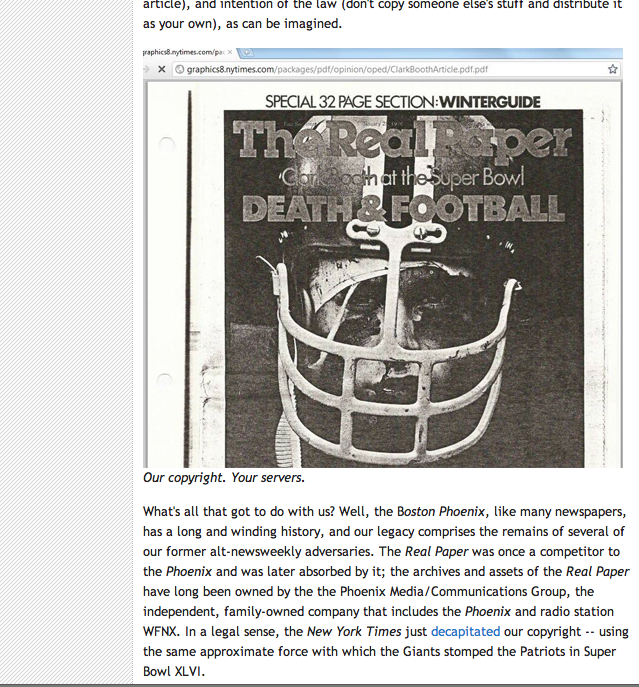Nope, that’s not true at all. I don’t. I don’t even live in New York. But, when Lindsay ONeal suggested that I write a post about this lengthy editorial on the Boston Phoenix’s PHLog, I decided to take the bait.
To summarize, the author is, shall we say, nonplussed that the New York Times recently chose to publish a .PDF copy of a “classic” 1976 article (not originally appearing in the Times) examining the injuries that football players sustain over the course of their careers. Citing an op-ed written by the Times’ former executive editor and the Times’ apparent successful efforts to have Pulse, a headline sharing app, pulled off the market within hours, the author contrasts the news giant’s protective stance when it comes to shielding its own content from unauthorized redistribution.
The author assumes for the sake of argument that the Times was able to track down the author of the 1976 article to obtain permission, but asserts that nonetheless the Times is in clear violation of the copyrights in the photos, layout and ad copy that attend the original article.
Without taking a stance on the matter, let me just say that as an intellectual property lawyer I generally come down on the side of enforcing the laws as they exist, with reasonable interpretation, unless and until they get changed. Of course, interpretations can (and perhaps should) change over time, as the times change while the laws remain the same. This is perhaps more true nowhere than in copyright law.
Copyright laws in the U.S. are designed to strike a careful balance by serving the competing interests of both facilitating advancement on the one hand, and protecting individuals’ creative output on the other. In fact, in copyright law these interests are largely one in the same (at least in theory), since granting exclusive rights serves as an incentive to engage in further creativity, and so on and so on.
One aspect of copyright law that extinguishes the “monopoly” theory of ownership is the doctrine of fair use. I’m sure you’re all so interested in the four-part legal analysis and balancing test, but suffice it to say that one important element is the “effect on the market for the original work.” So, while reprinting a .PDF of a 35-year old seminal article may well still impact the market for the content’s redistribution rights (but remember, we’re assuming permission has been obtained), the same might not be able to be said for low-quality scanned images and advertisements. In fact, assuming the ads are still relevant, presumably re-publication would actually benefit the advertisers and their design agencies. As far as layouts, can any one publisher really lay claim to exclusive rights in a layout? If the layout is fairly generic (with all due respect to the publisher), then it may not have sufficient creativity to even garner copyright protection in the first place.
So, all things considered, it seems to be far from an open-and-shut case that the Times has done anything wrong. That’s not to say that it hasn’t, but just that the answer isn’t clear. That said, for any publishers out there not confident in their rights to re-post something, why not simply seek permission to do so? Worst-case scenario, you will have respected someone else’s rights to their face, and you will have the opportunity to add your own contribution to the creative ethosphere.
This article is provided for informational purposes only, and does not constitute legal advice.







